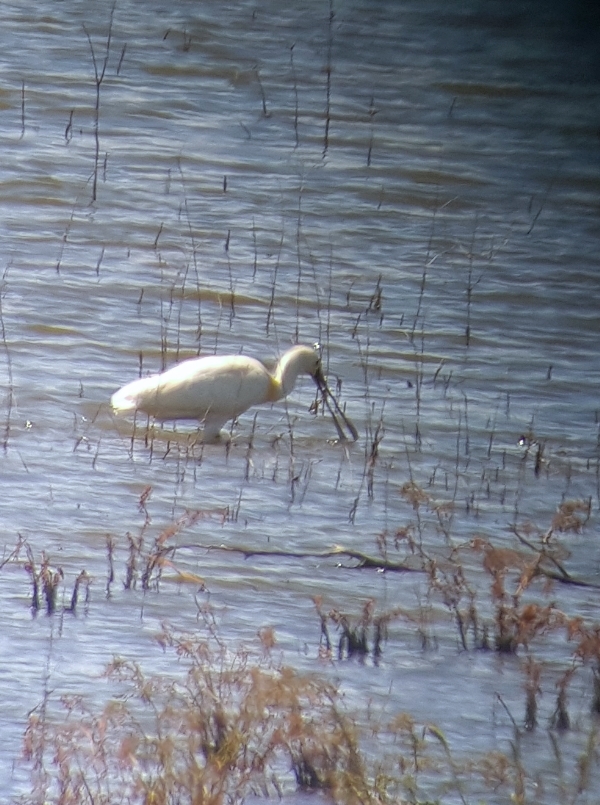
JARAICEJO HEATHLAND – 3 BRIDGE OVER THE ALMONTE – ALCOLLARIN RESERVOIR
WEATHER: cloudy all morning with a very chilly wind. Afternoon, bright sunny and warm. Temp 20C
It was a very cold start to our last day in Extremadura, it was overcast and a biting wind kept the temperature down below 10C. To top all of that were out on the heathland, the most open and exposed habitat.
Our target species on the heath were all warblers and all three of them played hard to get at first, I don’t blame them for not wanting to come to play in the cold temperatures that we were experiencing. Eventually we had great views of first, the Dartford Warbler, then the Spectacled Warbler and finally the Sardinian Warbler. All three were new for our list and they all showed very well.

this is the best I could do with the Spectacled Warbler
Other species seen on, or over, the heath were: Black Kite, Griffon Vulture, Short-toed Eagle, Crested and Thekla Larks, Iberian Shrike, Linnets, Goldfinches, lots of Corn Buntings and the odd Wood Pigeon.

a darty in the distance
We left the heath as the sun started breaking through the clouds and by the time we had driven down the road to the Rio Almonte we had warmed up a little. From the medieval bridge we had a panoramic view of the surrounding valley and of the two modern bridges.

two of the three Bridges, I was standing on the oldest when I took this picture
We listed a lot species in a short period of time, such as: Bee-eater, Hoopoe, White Wagtails, Stonechat, Sardinian Warbler, Common Nightingale, Woodchat Shrike, Linnet, Goldfinch and lots of sparrows of both, the English and the Spanish type. Along the river we picked out Grey Wagtail, Little Ringed Plover and Common Sandpiper.

Woodchat Shrike standing on the Medieval Bridge
From there we drove into Trujillo and bought our lunch supplies from the Dia supermarket. It would have been rude not to look for the Scop’s Owl as we were parked very close to their hotspot…..but we failed to see one for the second time.
The huge reservoir at Alcollarin was our next destination, we drove down to Zorita and turned onto the Alcollarin road. Just before the town there is a pool on the left and that is where we stopped first. A Purple Heron, a single Stork, a couple of Black-winged Stilts was all we saw.

we saw over 20 Eurasian Spoonbills at the reservoir today
Near the dam at the reservoir we stopped to look at a small colony of Bee-eaters before driving up the hill to view the reservoir. As is usual, all the birds were on the far shoreline, they were dots in the distance.
From a hiiltop, we scanned using our scopes, and found many species. A group of some fifteen or so Spoonbills were feeding together, they formed a tight group and dashed about in a frenzied pattern, each one was trying hard to be the leader of the group, it was comical to watch.
Many Great-crested Grebes dotted the surface of the water as did Mallards and Gadwall and we picked out one two waders. Greenshank and Common Sandpipers were identified. We then drove on to a second, much smaller dam where we had much better luck and much closer sightings.

A Great Reed Warbler gave us the run around in a tiny patch of reeds, it was so easy to hear and yet so hard to see. We found many more species from the wall of the dam including a Pair of Kingfishers, White & Yellow Wagtails, Melodious Warbler, Sardinian Warbler, Zitting Cisticola and Marsh Harrier.
A marshy area was fairly close to us and lots of birds were feeding there, we saw Wood Sandpiper, Greenshank, Common Sandpipers, Common Snipe and the usual Stilts. We spent a good hour standing on the dam watching many species in good light with a nice cooling breeze.
After that we drove as far as we could around the reservoir to try to get closer to distant birds which we managed to some degree. We got much closer views of Wood Sandpiper, Greenshank and Common Sandpiper but we did not find anything new or any other species of duck.
The track deteriorated and turned away from the water so we turned back. We nearly had trouble with a very large bull, he refused to move off the track, so I had to manoeuvre around him just scraping past. On the way back he was sitting on the track but luckily he left enough space for us to pass.
After a coffee and an ice-cream in Zorita we headed back, arriving at the hotel around 5:30pm. We had enough time to pack ready for our departure tomorrow. We are heading to Coto Donana and we hear that it is extremely dry with hardly any water! How can they let this happen to one of the most important wetlands in Western Europe?
